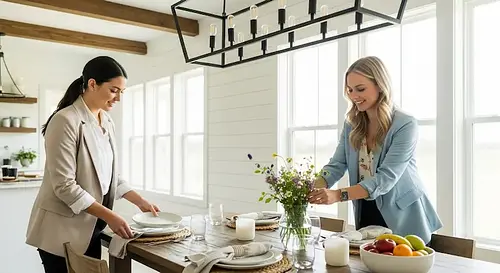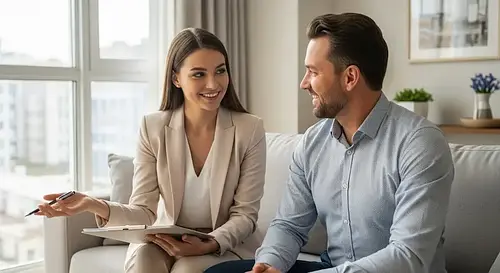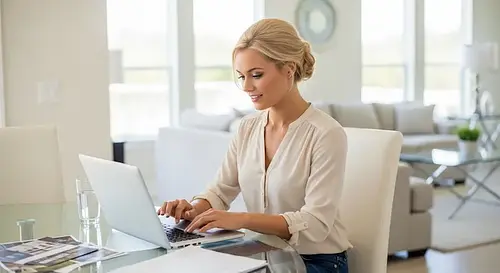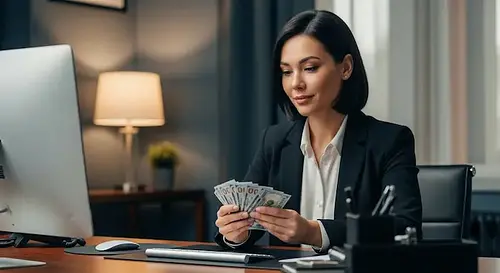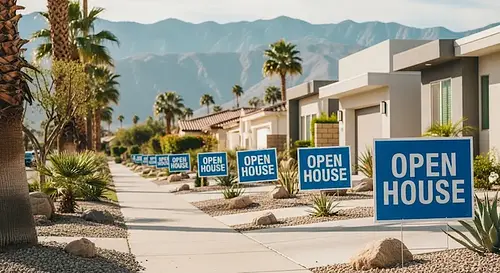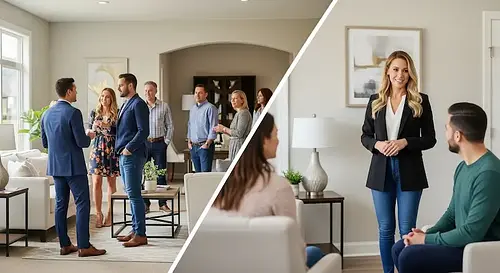How To Stage Your Home For An Open House
Want to make a lasting impression at your next open house? Learn how to stage your home for an open house with this step-by-step guide covering cleaning tips, decorating strategies, and room-by-room styling advice that helps buyers fall in love—and make an offer.

Written by Seth Cox
Jun 19, 2025 / Open house marketing
Unlike staging for photos or virtual tours, staging a home for an open house is about creating an in-person experience. From lighting and scent to furniture flow and cleanliness, every detail influences how buyers emotionally connect with the space. The goal isn’t just to make your home look good—it’s to make visitors feel at home.
In this guide, we’ll show you exactly how to prepare your home for an open house with proven staging tips, cleaning checklists, decorating strategies, and day-of presentation advice. Whether you're selling on your own or working with an agent, you'll learn how to turn your property into a show-ready home that buyers won’t forget.

Why Staging Matters for Open Houses
Buyers Decide in the First Few Minutes
- Clear, open spaces make rooms feel bigger
- Inviting scents and soft lighting put buyers at ease
- Neutral decor helps visitors mentally “move in”
Staged Homes Sell Faster and for More
- Staged homes sell 3x faster on average
- Many sellers see a 5–15% return on staging investment
- Even DIY staging can have measurable impact during open houses
Open House Visitors Are Evaluating, Not Just Browsing
- Staging creates a sensory experience: sight, smell, feel
- It guides attention to your home’s best features
- It builds trust by showing the home is cared for and move-in ready

How Staging for an Open House Differs from Photo Staging
Open House Staging is About Movement and Flow
- Make sure buyers can move naturally from room to room
- Avoid blocking walkways or crowding furniture into corners
- Use rugs or decor to subtly guide foot traffic through key areas
In-Person Staging is a Full-Sensory Experience
- Use subtle scents (like citrus or vanilla) to freshen the air
- Play soft background music to create a relaxed mood
- Adjust the thermostat so the home feels comfortable year-round
Buyers Linger—and Look Closer
- Clean everything, especially places photos might skip
- Remove overly personal items that distract from the space
- Stage even small or awkward areas to show their potential

Pre-Staging Prep: What to Do Before Styling for an Open House
Deep Clean Every Surface Buyers Will See (and Smell)
- Mop floors, scrub baseboards, and wipe down all surfaces
- Clean windows inside and out to maximize natural light
- Remove pet odors, trash smells, and mildew from bathrooms
Declutter, Depersonalize, and Make Space Feel Bigger
- Clear off countertops, coffee tables, and shelves
- Pack away family photos, trophies, mail, and pet items
- Edit furniture down to essentials—more space = more appeal
Handle Quick Fixes and Minor Repairs
- Tighten loose handles, fix squeaky doors, and patch holes
- Touch up paint in high-traffic areas
- Replace any dead bulbs or broken light switches
Let in the Light and Fresh Air
- Open blinds and curtains to let in natural light
- Replace outdated or dim bulbs with warm white LEDs
- Crack windows before the open house to let in fresh air (weather permitting)

Room-by-Room Staging Tips for Your Open House
Entryway: Make a Memorable First Impression
- Add a fresh doormat and small accent rug
- Use a mirror to reflect light and create a sense of space
- Include a small bench or console table with a neutral accent piece
Living Room: Create a Space to Relax and Gather
- Pull furniture away from walls to define the space
- Use light throw pillows, a soft blanket, and a coffee table vignette
- Keep décor minimal: 1–2 neutral art pieces and greenery work well
Kitchen: Keep It Clean, Bright, and Functional
- Clear all counters except 1–2 styled elements (e.g., fruit bowl, cookbook)
- Clean appliances inside and out—buyers often peek inside ovens
- Remove magnets, notes, and clutter from the fridge
Dining Room: Suggest Lifestyle, Not Formality
- Set the table with 2–4 place settings (simple plates, napkins, glasses)
- Add a neutral centerpiece like a vase of fresh flowers or greenery
- Avoid overly formal setups or holiday themes
Bathrooms: Make Them Feel Like a Spa
- Use all-white towels for a clean, hotel-like look
- Remove personal items like toothbrushes, razors, and medications
- Add a new soap pump, a candle, or a small plant for a soft touch
Bedrooms: Keep It Calm, Clean, and Gender-Neutral
- Use fresh, neutral bedding with just a few accent pillows
- Clear nightstands except for a lamp and 1 decorative item
- Remove toys, laundry hampers, and excessive furniture
Home Office (If Applicable): Highlight Remote Work Potential
- Set up a tidy desk with a lamp and laptop or notebook
- Use a simple chair that matches the style of the home
- Add a plant or framed art to bring life to the space
Outdoor Areas: Extend the Living Space
- Sweep patios and porches, mow the lawn, and remove weeds
- Stage a seating area with cushions, a small table, or string lights
- Add a doormat and seasonal plants near the front entry

What to Do Right Before the Open House Starts
Final Walkthrough: Reset and Refresh Every Room
- Turn on every light in the house (even closet lights)
- Open all curtains and blinds to maximize natural light
- Close toilet lids, straighten pillows, and fluff bedding
- Empty all trash bins and take them out of the house
- Do one last wipe-down of countertops, mirrors, and floors
Set the Atmosphere: Light, Sound, and Scent
- Set the thermostat to a comfortable temperature
- Play low-volume instrumental or light jazz music
- Use natural scents like lemon, vanilla, or cedarwood (avoid artificial sprays)
- Consider simmering cinnamon sticks or baking a tray of cookies for a cozy aroma
Create Flow and Remove Friction
- Leave all interior doors open (except personal closets or storage rooms)
- Ensure pathways are clear—remove shoes, toys, or pet gear
- Place rugs flat, tuck away cords, and tape down loose edges
Set Up Your Sign-In and Marketing Materials
- Place the sign-in station near the entry or kitchen where it feels natural
- Have listing flyers, floor plans, or brochures available nearby
- Keep pens, clipboards, or tablets tidy and accessible

Common Open House Staging Mistakes to Avoid
Overdecorating or Overpersonalizing the Space
- Stick to neutral colors and simple design
- Remove personal collections, hobby gear, or sports memorabilia
- Limit decorative items to 1–2 per surface
Ignoring Smells and Sounds
- Don’t rely on overpowering air fresheners—go natural
- Neutralize odors from pets, cooking, or moisture
- Play soft music in the background to create ambiance
Blocking Light or Pathways
- Avoid blocking windows with furniture or heavy curtains
- Ensure there’s a clear, natural walking path through each room
- Use mirrors strategically to reflect light and open up space
Leaving Behind Visible Clutter
- Hide everyday items like phone chargers, remotes, and cleaning supplies
- Don’t forget closets, pantries, and laundry areas—they should feel spacious
- Remove pet bowls, litter boxes, and toys
Staging Rooms Without a Clear Purpose
- Stage awkward areas as reading nooks, offices, or mudrooms
- Use minimal furniture to define function without crowding
- Every square foot should feel intentional and usable

Should You Hire a Professional Home Stager?
While many homeowners can tackle basic staging on their own, sometimes it makes sense to bring in an expert. Professional home stagers know how to transform a space specifically for buyer psychology—especially during an open house. If you’re selling in a competitive market or want to maximize your sale price, hiring a stager could be a smart investment.
When It’s Worth the Investment
- Your home is vacant and needs full staging
- You’re short on time or overwhelmed by the prep process
- You’re selling a luxury property or targeting high-end buyers
- You’ve already had showings without offers
- Your agent recommends it to stand out in the current market
What It Costs—and What You Might Gain
- Basic consultations start around $200–$500
- Full-service staging can range from $1,000–$3,500 or more
- NAR data shows staged homes sell for 5% to 15% more on average
DIY Staging Can Still Work—If Done Right

Using Technology to Elevate Your Open House Staging
Capture Leads with Style
- Set up a clean, branded digital sign-in station
- Automatically follow up with attendees after the open house
- Share staged photos, listing details, and agent contact info
- Capture every lead, even if you're not the listing agent (with team access)
This modern tool adds polish to your open house staging and ensures no buyer slips through the cracks.
Use Virtual Staging to Highlight Potential in Empty or Awkward Spaces
- Display virtually staged images on a tablet or poster board
- Use QR codes to let guests explore multiple layouts or furniture styles
- Great for rooms like bonus spaces, basements, or offices
Integrate QR Codes for Deeper Buyer Engagement
- A digital brochure or photo gallery
- Floor plans, neighborhood guides, or renovation highlights
- Showable-hosted property pages for easy follow-up
Tip: Place a small sign with a QR code on the kitchen counter or next to your sign-in tablet to drive engagement naturally.
FAQs About Staging Your Home for an Open House
How far in advance should I stage for an open house?
What are the most important rooms to stage?
- Entryway
- Living room
- Kitchen
- Primary bedroom
- Bathrooms
Can I stage my home myself, or should I hire someone?
What scents are best during an open house?
Should I stay home during the open house?

Conclusion: Staging for Open House Success
When you’re inviting buyers into your home, you’re not just showing a property—you’re telling a story. Effective open house staging transforms your space into a place buyers can see themselves living. And that emotional connection is what leads to offers.
From deep cleaning and decluttering to styling each room with intention, every detail matters. But the magic of staging goes beyond decor—it’s about creating comfort, flow, and a sense of possibility. Combine that with strategic lighting, scent, and modern tools like digital sign-ins, and your open house becomes an experience buyers remember long after they leave.
The takeaway? Staging your home for an open house isn’t optional. It’s a strategic advantage. Whether you go the DIY route or bring in a pro, the effort you put in will pay off with stronger interest, better feedback, and ultimately, a faster sale at a better price.

